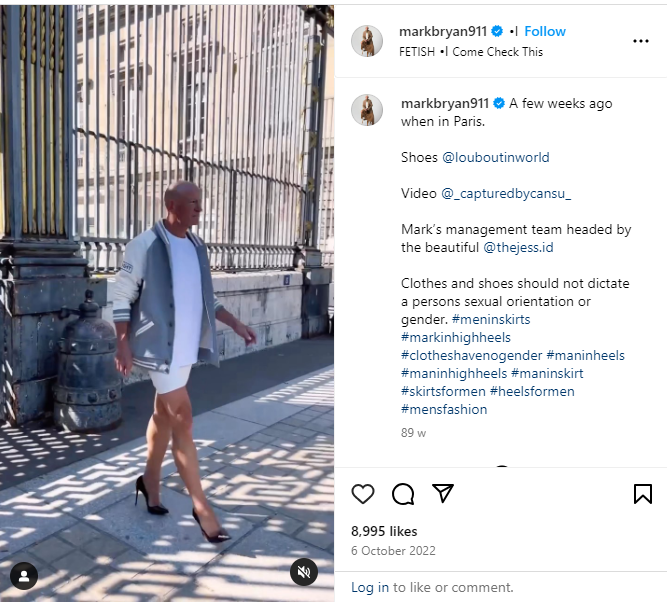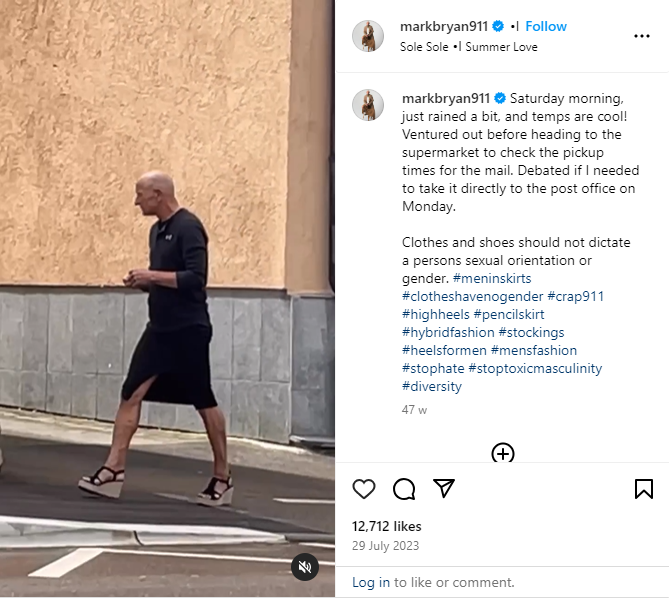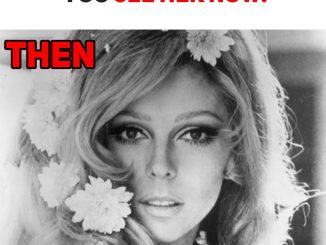
Mark Bryan is a robotics engineer who has been married for 11 years and has a daughter. He identifies as straight and chooses to dress unconventionally. Bryan is an American living in Germany, and he doesn’t believe that fashion has to be gendered. You can find Bryan wearing a skirt and heels to work or out anywhere else he goes on any given day.
Bryan said he doesn’t like how limited men’s choices are in the fashion department, especially when it comes to office attire. Men’s pants only come in a few colors, mostly black, gray, dark blue and the occasional pinstripe, and cuts.
The stylish dresser believes that if women are allowed to wear pants, men should be able to wear skirts and dresses as well. Bryan likes how skirts come in many styles and patterns – and many more colors – unlike men’s clothing.

Bryan prefers to mix traditional gender looks by wearing masculine attire on his top half, like a blazer and tie, and traditionally feminine attire on the bottom half. He will typically wear a pencil skirt and four-inch heels on the bottom.
Wearing high heels is no problem for Bryan. He first learned how to do it when his college girlfriend asked him to wear high heels while dancing with her so that they were on the same level. They continued this for over a year.
Bryan doesn’t let stereotypes or assumptions stop him from dressing in a way that brings him joy. He challenges expectations and does so unapologetically. Keep reading to hear what Bryan has to say about his fashion choices.
Bryan has a very clear idea about how he likes to dress. He told Bored Panda: “To me, clothes have no gender. I prefer skirts to dresses. Dresses don’t allow me to mix the genders. I prefer a ‘masculine’ look above the waist and a non-gendered look below the waist. It’s all about clothes having no gender.”
He continued: “I am old enough to remember that in school, the girls could not wear pants. Pants have now become a non-gendered article of clothing. So why can’t skirts and heels be non-gendered? Besides, men wore heels before women did. Maybe not today’s stiletto-style heels, but men did wear heels before women.”

Bryan is correct about that. High heels can look back on a long history. Although historians and archaeologists cannot date their invention clearly, they have been around at least since the 10th century. And they were not a fashion statement at first. No, the first recorded use of high heels was eminently practical: the Persian cavalry wore boots with heels, called a kalash or galesh, that made it easier for them to keep their feet inside their stirrups. This is, by the way, the same reason why cowboy boots have a small heel as well!
Since owning a horse was a sign of wealth, only well-off men could afford to wear these high-heeled boots. The use of them slowly spread across Europe, and high heels heels became one of the fashion signs of rich noblemen or traders. In fact, following the Great Schism of the Christian Church in the 11th century, even the pope wore high heels.
It wasn’t until several hundred years later that fashion slowly changed. During the 18th century, cultural concerns in Europe came up about the distinction between males and females and talk about what men and women should wear arose. This is the point in time where the belief that fashion is something effeminate and frivolous that “real men” shouldn’t care about hails from. Due to these changing beliefs, men largely abandoned high heels heels, as they were seen as impractical and mere accessories.

Bryan is one of the examples of how high-heels are slowly coming back as an accepted form of footwear for men. Although the engineer champions the option of wearing high-heeled shoes for men, he understands many people will look twice when they see him. He compares his style choices to someone who chooses to dye their hair bright colors. He explained:
“Take a person with bright green hair. Green hair is not normal. You look up and see this person, your mind tells you it’s a person with green hair, you think to yourself, that’s odd or interesting, then you go back to do what you were doing and don’t give it another thought. I believe this is the same when people see me in a skirt and heels.”
Bryan doesn’t have to struggle to find skirts and heels that fit him either. He wears a size 8 in skirts, and with smaller feet for a man, his shoe size in heels is 8.5. If you know a man who is considering trying out wearing heels and skirts too, Bryan suggests starting with a lower heel until you feel more comfortable walking in high heels.
What do you think of Mark Bryan’s style choices? Do you know any men who would try walking in high heels? Let us know, and be sure to send this along to your friends and family.
I Met a Man at a Speed Dating Event – When I Showed His Photo to My Mom, She Instantly Contacted the Police

After a fun night of speed dating, I showed my mom a photo of the guy I met. She freaked out and immediately called 911. I was shaken, but what I discovered the next day when things got really wild left me gasping for air.
My palms were sweating as I smoothed down my dress for the hundredth time. The restaurant’s dim lighting couldn’t hide the anxiety radiating from the other speed daters around me. At 30, I never thought I’d be here, but my best friend Lily’s persistent nagging had finally worn me down.
“You’ve got this, Selena,” I whispered to myself, taking a deep breath. The bitter scent of wine and the soft clink of glasses filled the air, doing little to calm my nerves.
The bell rang with a shrill sound that made me jump. It signaled the start of our first round.
I plastered on my best smile as a tall, dark-haired man slid into the seat across from me. My breath hitched as our eyes met.
“Hi, I’m Robin.”
I felt an instant spark, like electricity coursing through my veins. “Selena. Nice to meet you.”
I found myself leaning in as we chatted, captivated by his stories and wit. He spoke of his work as a software engineer, his love for rock climbing, and his dreams of traveling the world.
With each word, I felt myself falling deeper under his spell.
When the bell rang again, Robin stood up, hesitation brimming in his eyes as he gripped the back of the chair.
“Listen, I know this is unconventional, but would you like to grab a coffee after this? I’d love to continue our conversation.”
My cheeks flushed, and my heart raced. “I’d really like that. Tomorrow? I said, feeling the heat creep into my cheeks as he kissed the back of my hand.
“Sure! Will be waiting for you in the café downtown!”
As we left the restaurant later that night, I couldn’t shake the feeling that my life was about to change forever.
The next afternoon, I couldn’t stop smiling as I recounted my evening to my mom, Daisy.
“He sounds wonderful, honey,” she said, her eyes crinkling with happiness. “I haven’t seen you this excited about someone in years.”
“I know, Mom. There’s just something about Robin. It’s like… like I’ve known him my whole life.”
“Well, don’t get ahead of yourself. But I am happy for you. Do you have a picture?”
“Oh! Yeah, we took a selfie.” I pulled out my phone, swiping to find the photo. My heart fluttered as I looked at Robin’s smiling face. “Here he is!”
The moment I turned the screen towards her, Mom’s face turned pale.
“Mom? What’s wrong?” I freaked out.
Her eyes were wide with panic, fixed on the phone screen. “Selena, oh my God… it’s HIM. The man who robbed my friend Janet! CALL THE POLICE RIGHT NOW!”
“What? No, that can’t be right.” I shook my head, confusion and disbelief warring inside me.
“I’m telling you, it’s him! He conned Janet out of her life savings. Promised to marry her, took every penny she had, and then vanished! We need to call the police right now, honey!”
My stomach dropped, a cold dread seeping into my bones. “Are you sure?” I asked, desperately hoping she was mistaken.
“Positive. Janet showed me his picture a hundred times when we were trying to track him down. I’d never forget that face.”
I stared at Robin’s smiling face on my phone, feeling sick. The warm brown eyes that had seemed so kind now looked calculating. The charming smile now seemed sinister. How could I have been so blind?
Mom reached for her phone, her fingers shaking as she started to dial 911. Without thinking, I grabbed her wrist, stopping her. “Mom, wait!”
“What do you mean, wait? We need to turn him in!”
“If we call now, he might get spooked and disappear again,” I said slowly, a plan forming in my mind. “But, what if we set a trap?”
Mom’s eyebrows shot up. “What are you thinking?”
“I have a date with him tomorrow night. What if I go, act normal, and you call the police to meet us there?”
She hesitated, worry etching lines across her forehead. “I don’t like the idea of you being alone with him. He’s dangerous, Selena.”
“It’ll be in a public place, Mom,” I assured her, even as my heart raced at the thought. “And think about it. This might be our only chance to catch him. To get justice for Janet and who knows how many others.”
After a long moment, she nodded, fear still lingering in her eyes.
As we began to plot our plan, I couldn’t shake the feeling that I was balancing on a knife’s edge. One wrong move and everything could come crashing down.
The next evening, I sat across from Robin at a cozy café, my nerves on edge. He looked as handsome as ever in a blue shirt that brought out his eyes.
But now, his charming smile made my skin crawl. Every compliment and every gentle touch of his hand on mine felt like a lie.
“You look beautiful!” Robin said, reaching for my hand across the table.
I forced myself not to flinch away, plastering on a smile that felt more like a grimace. “Thank you. You look nice too.”
As he launched into a story about his day, I discreetly texted Mom under the table, “Now!”
“So, tell me more about your family,” I said, desperate to keep the conversation going.
A shadow seemed to pass over Robin’s face so quickly that I almost missed it. “It’s complicated,” he said after a moment.
Before I could probe further, I saw two uniformed officers enter the café.
They approached our table, and Robin’s easy smile faltered. “Is there a problem, officers?” he asked, his eyes darting between them and me.
One of them stepped forward, his hand resting on his belt. “Sir, we need you to come with us for questioning.”
“Selena, what’s going on?”
“I’m sorry, Robin. But we know what you did to Janet. And probably to countless other women.”
I thought this was it. But what happened next left me reeling.
After a tense conversation with the officers, during which Robin vehemently denied knowing any Janet, they released him. And he walked back to our table.
“Selena, I don’t understand. Who’s Janet? What’s this all about?”
I blinked, utterly lost. This wasn’t how it was supposed to go. He was supposed to be led away in handcuffs, not standing here looking at me like I’d betrayed him.
“The woman you conned. My mom’s friend. You… you took everything from her.”
Robin shook his head, running a hand through his hair. “I’ve never met anyone named Janet in my life. But, wait a minute, I think I know what happened here.”
He pulled out his phone, his fingers flying across the screen. After a moment, he turned it towards me. I gasped, my hand flying to my mouth.
The photo showed two identical men — Robin, and another who could have been his clone. Same eyes, smile, and same everything.
But while Robin looked relaxed and happy in the photo, his double had an edge to him, a hardness in his eyes that sent a chill down my spine.
“That’s my twin brother, Adrian,” Robin revealed. “We haven’t spoken in over six months. He’s had some trouble with the law. I’ve been trying to help him, but he disappeared. I think he might be the one you’re looking for.”
I felt the blood drain from my face, shame and horror cloaking me in equal measure. “Oh my God. Robin, I’m so sorry. I thought—”
He held up a hand, cutting me off. “It’s okay. I understand. Anyone would have done the same thing in your shoes.”
But I could see the hurt in his eyes. I’d accused him of being a criminal and had the police come after him. Would he ever forgive me?
As if on cue, Mom burst into the café, her eyes wild as she scanned the room. When she spotted us, she rushed over, stopping short when she saw Robin still sitting there.
“What’s going on? Why isn’t he in custody?”
I stood up, placing a hand on her arm. “Mom, we made a mistake. A big one.”
Robin stood as well, offering his hand to my mother. “Mrs…?”
“Daisy,” Mom said, frowning.
“Mrs. Daisy, I understand there’s been a misunderstanding. I’m not the man who hurt your friend. But I think I might know who did.”
He showed her the photo, and I watched as the same shock I’d felt played across Mom’s face.
“I can’t believe it,” she murmured, looking between Robin and his brother’s picture. “They’re identical.”
“Adrian and I… we’ve always been close. Or we were. But lately, he’s been making some bad choices. I’ve been trying to help him, but he disappeared a few months ago. I’ve been worried sick.”
I reached out, touching his arm before I could stop myself. “I’m so sorry for putting you through this, Robin. I feel terrible.”
He gave me a small smile, but it didn’t reach his eyes. “Don’t. You were trying to do the right thing. To protect others from being hurt.”
Mom shook her head, sinking into a chair. “I can’t imagine how hard this must be for you, dealing with your brother’s actions.”
Robin’s smile faded completely. “It’s been challenging. But I’m not giving up on him. I can’t.”
An awkward silence fell over the table. I fidgeted with my napkin, trying to find the right words to fix this mess I’d created.
How do you apologize for accusing someone of being a criminal? For bringing the police down on an innocent man?
Finally, I took a deep breath, steeling myself. “Robin, I know this isn’t how either of us imagined this evening going. And I completely understand if you never want to see me again. But, if you’re willing, I’d love to start over. Maybe we could try another date? One without any police involvement or mistaken identities?!”
He looked at me for a long moment. My heart raced as I waited for his response. Finally, he broke into a genuine grin, the warmth returning to his eyes.
“I’d like that, Selena. I’d like that a lot!”
As we left the café, walking into the cool night air, I couldn’t help but feel that despite all the chaos and misunderstandings, this might just be the beginning of something wonderful.
And terrifying. Because now, somewhere out there, was a man who looked exactly like the one beside me. A man who was everything I’d feared Robin to be.



Leave a Reply